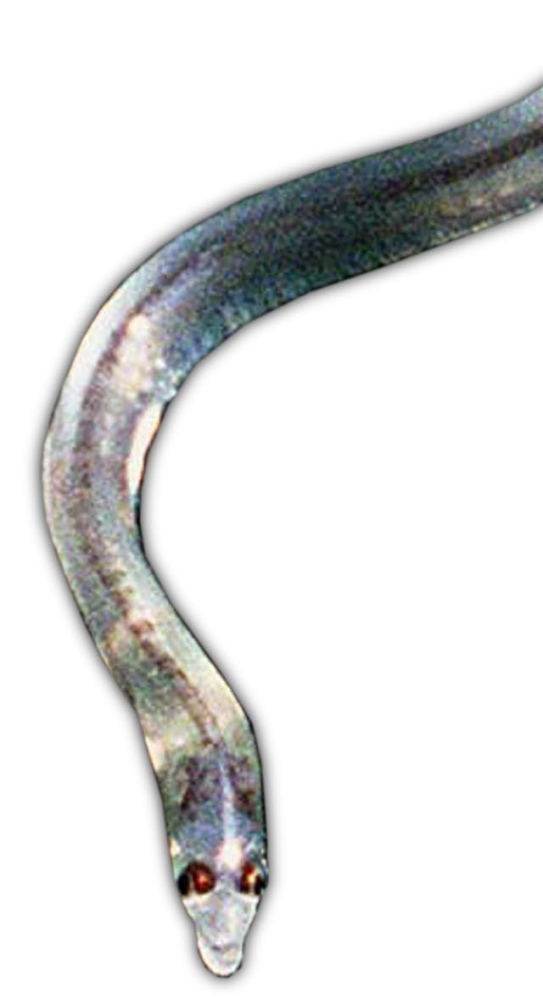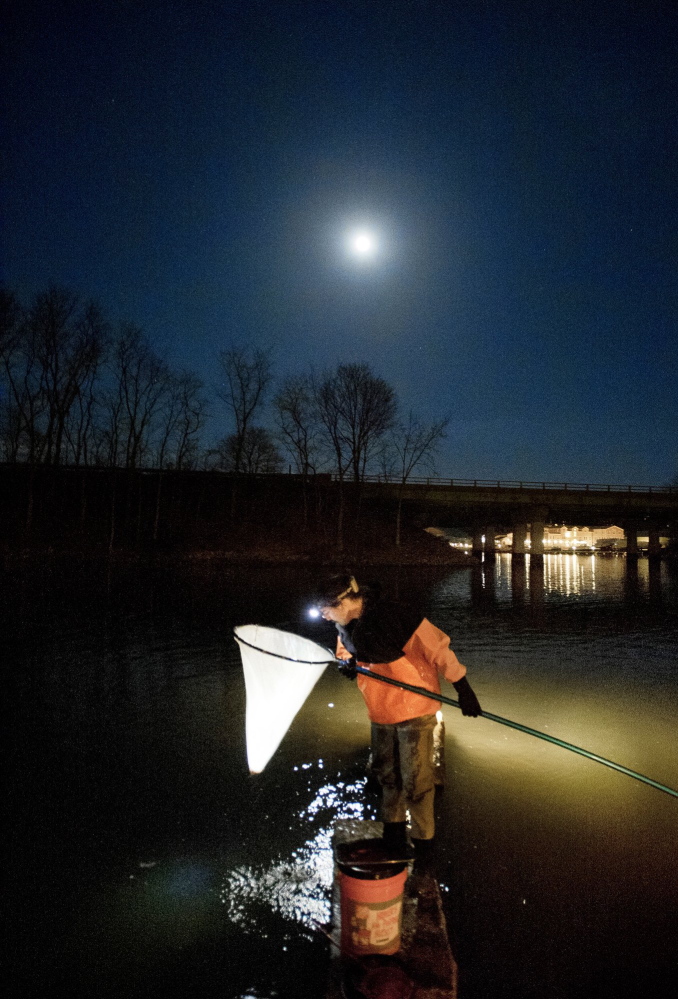Under scrutiny from federal regulators, Maine will open coastal streams on Sunday to fishing for tiny, translucent eels under a strict new monitoring system that, if successful, could turn a Wild West-like fishery into a national model.
Over the span of a few years, Maine’s elver fishery grew from a little-noticed venture into a $40 million industry involving heavily armed men guarding large piles of cash and “glass” eels worth up to $2,000 a pound.
Hundreds of state-licensed fishermen – as well as unlicensed poachers – jockeyed to catch as many of the baby eels as possible, with many earning six figures in just a few months.
The 2014 season brings significant changes to what has grown into Maine’s second-largest commercial fishery, however.
For the first time, fishermen will be required to stay within individual catch quotas in response to rising concerns about the sustainability of one of only two elver fisheries in the U.S. Maine also is implementing an electronic swipe card system that will allow regulators to monitor how many eels are being caught daily and shut down individual fishermen – or the entire season – if limits are exceeded.
A first of its kind on the East Coast, the electronic monitoring system is regarded as a test run for other fisheries in Maine and elsewhere.
“We will definitely be carefully watching how well it works,” said Tina Berger, spokeswoman for the Atlantic States Marine Fisheries Commission, the federal fisheries management board for the eastern seaboard. “I’m sure if it shows utility there (in Maine) it would be something we would consider for other fisheries.”
Elver fishermen, while not thrilled about a 35 percent reduction over last year’s glass eel haul, hope the additional monitoring will help fend off calls for a total closure by groups that contend dams, turbines and other human factors have diminished the American eel population.
“I think it will be a good season,” said Jeff Pierce with the Maine Elver Fisherman Association. “In the past there have been a lot of eels around. We don’t think the species is declining and we think all of the conservation measures taken in the past are finally coming to fruition.”
In 2013, Maine fishermen reported landing more than 18,000 pounds of the tiny eels, worth about $33 million. That is down from 2012 but still ranks the elver fishery second only to the iconic Maine lobster in terms of total value.
It’s unclear how much fishermen will receive per pound in 2014, although new or expanded fisheries in several other countries – including Canada, Haiti and the Dominican Republic – could suppress the price paid in Maine.
“The buyers have been very, very quiet,” Pierce said. “We have inquired with a number of buyers … but I don’t think we will know until Sunday.”
Born from eggs spawned in the Sargasso Sea near the Bahamas, the tiny eels are carried by currents to land. They eventually show up as translucent “glass eels,” or elvers, in streams and rivers from the Caribbean to Greenland.
Those eels may spend 15 to 20 years in Maine’s freshwater rivers and streams before swimming thousands of miles back to the Sargasso Sea to spawn. While some Maine fishermen do target adult or juvenile eels, glass eels are the most valuable, by far.
Fishermen use large, funnel-shaped “fyke” nets or hand-held nets to corral elvers swimming near the stream banks. It is cold, long, unpredictable work often carried out at night over several months.
This year’s season is starting later than normal in order to give the Maine Department of Marine Resources more time to implement the recent regulatory changes. But fishermen said Mother Nature has introduced her own delay because elvers won’t typically begin their upstream migration until the ice melts and waters warm somewhat.
Darrell Young, an Eastbrook elver fisherman who founded the Maine Elver Fisherman Association, said he isn’t expecting the elvers to really start running until late April, although he’ll be staking out his spot when the season opens at noon Sunday.
“I’ll put my net in and sit back and wait,” Young said.
Elver fishing can also be extremely lucrative, as evidenced by a fisherman from Ellsworth, Danny Deraps, who recently pleaded guilty to state charges of income tax evasion and theft for reporting only part of the $700,000 he earned on elvers in 2012.
Dealers for Asian aquaculture farms largely in Japan and China have paid up to $2,600 a pound for Maine elvers in recent years. Those prices have renewed interest in elver fishing in other states and countries, but they have also elevated concerns about the health of the American eel, which the U.S. Fish and Wildlife Service is considering listing as a threatened or endangered species.
“Given where the Atlantic States Marine Fisheries Commission was headed going into the season, … the state is pretty fortunate to be looking at a quota reduction of only 35 percent,” said Jeff Nichols, spokesman for the Maine Department of Marine Resources.
After months of discussion at the commission, Maine will impose an 11,749-pound quota on elvers this year. More than 400 fishermen will divvy up about three-quarters of that quota, while Maine’s four Native American tribes will allocate individual quotas totaling 1,650 pounds.
Tensions between the Department of Marine Resources and the tribes have heightened since last year when the Passamaquoddy Tribe – asserting what members said were their sovereign rights to a fishery – issued about 300 more elver permits than the state authorized. Tempers flared when Maine Marine Patrol officers, state police and game wardens seized some Passamaquoddy nets.
Negotiations between the tribe and DMR officials fell apart this winter after the Attorney General’s Office raised constitutional concerns. The Joint Tribal Council of the Passamaquoddy Tribe voted recently to adopt the 1,650-pound total quota allocated to individual fishermen, as the DMR has suggested.
But the two sides remain at an impasse over the larger issue of the state’s authority to regulate tribal fishing.
“They do not have any authority,” said Newell Lewey, a member of the Joint Tribal Council. “We didn’t want any conflict [this year] but we also wanted to assert our own rights to pass tribal law, and we did that, asserting that we have inherent tribal saltwater fishing rights.”
Meanwhile, DMR officials have been testing the electronic monitoring system and began distributing the credit card-like “swipe cards” to fishermen last week. Officials also held several meetings with dealers to ensure all parties understand the new rules.
“The idea is when an individual hits his or her quota, the card will be deactivated,” Nichols said. “But as we have said, it is also incumbent on the individual to keep track of their landings to make sure they don’t go over their quota.”
Col. Joe Fessenden, the chief law enforcement officer at DMR’s Marine Patrol, said he believes the swipe cards and daily reports will go a long way toward tracking the fishery and reducing poaching. The electronic system and other changes will also help make law enforcement more efficient, he said.
Dealers who buy elvers are only allowed to purchase from licensed fishermen with active swipe cards and must keep detailed records accounting for each pound of eels. And dealers or fishermen who violate the rules could have their catch seized and be fined, as well as lose their licenses for this year and next.
The switch to paying fishermen via checks during last year’s season also strengthened the paper trail and is hoped to have reduced the likelihood of problems involving armed dealers and fishermen carrying large amounts of cash, Fessenden said.
DMR officials confirmed that if the swipe cards work for elvers, the state will likely explore expanding the technology to the scallop and urchin fisheries, both of which are tightly regulated because of past overfishing and concerns about the species’ health.
Fessenden said the technology, while new to fishing, has been kicking around in other forms for years. The challenge will be working out the bugs in the system, he said.
“We are the guinea pigs right now,” Fessenden said. “We are the test case and there is a lot riding on it.”
Kevin Miller can be contacted at 317-6256 or at:
kmiller@pressherald.com
Send questions/comments to the editors.





Comments are no longer available on this story